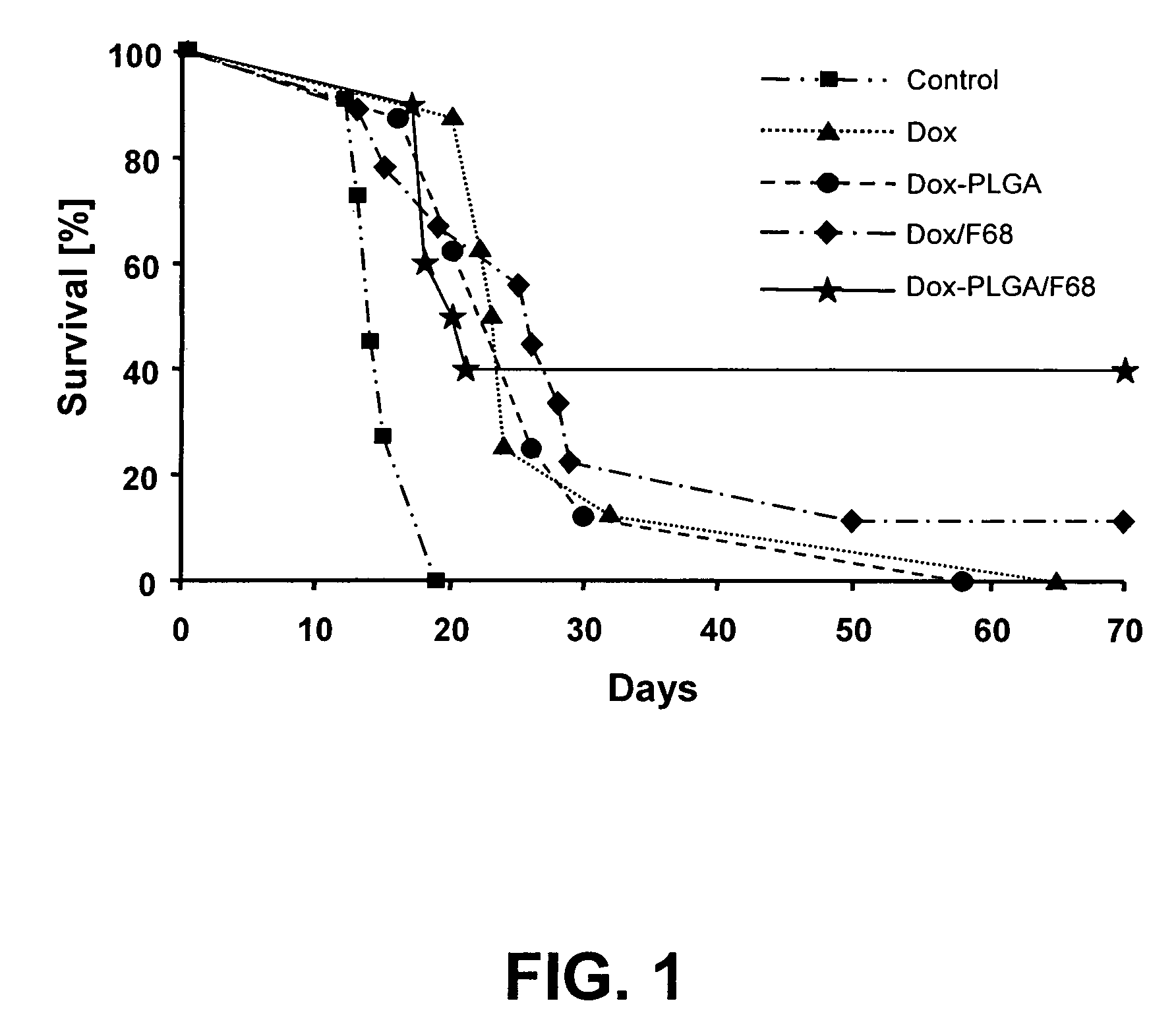Polylactide nanoparticles
a technology of polylactide nanoparticles and nanoparticulates, which is applied in the direction of nanotechnology, digestive system, metabolism disorders, etc., can solve the problems of drug administration only therapeutically effective when administered, and cannot pass the blood-brain barrier
- Summary
- Abstract
- Description
- Claims
- Application Information
AI Technical Summary
Benefits of technology
Problems solved by technology
Method used
Image
Examples
examples
1. Preparation of Nanoparticulate Formulations
[0091]Various grades of LACTEL® polymers—poly(DL-lactide) (PLA) and poly(DL-lactide-co-glycolide) (PLGA)—were purchased from Absorbable Polymers, USA; doxorubicin hydrochloride was a generous gift from Sicor, Rho, Italy; cetyl phosphate, potassium cholesteryl sulfate, polyvinyl alcohol (PVA) (MW 30-70 kDa), and human serum albumin (HSA) were purchased from Sigma; D-α-tocopheryl polyethylene glycol 1000 succinate (TPGS) was purchased from Eastman Chemical Company, USA.
[0092]The drug-loaded PLA and PLGA nanoparticles were produced either utilizing the high pressure homogenization-solvent evaporation technique or the double emulsion technique.
[0093]For high pressure homogenization-solvent evaporation, the polymer and the drug were usually dissolved in dichloromethane. This organic phase was slowly poured under stirring into an aqueous solution of a stabilizer (PVA or HSA). The mixture was emulsified using a high speed shear homogenizer (ULT...
preparation 1
[0109]Nanoparticles were prepared by a high pressure homogenization-solvent evaporation technique. 250 mg of the polymer (PLGA 75:25, MW 90,000-126,000 Da) and 25 mg doxorubicin were dissolved in 5 ml of dichloromethane. The organic phase was poured into a stirred aqueous solution (25 ml) containing 0.5% of PVA as stabilizing agent and the mixture was emulsified using an ULTRA-TURRAX® T-25 (2 min; 15,100 rpm). The resulting primary emulsion was further homogenized using a high pressure homogenizer (APV Micron Lab 40) at 400 bar. Dichloromethane was evaporated under reduced pressure (rotor evaporator BUCHI® R-200). The resulting nanosuspension was filtered through a glass-sintered filter and freeze-dried after addition of 5% w / v mannitol as a cryoprotector. The freeze-dried formulation was completely resuspendable. The particle size measured by PCS was 140-220 nm, doxorubicin loading was 40%.
preparation 2
[0110]Nanoparticles were prepared by a double emulsion technique. 500 mg of the polymer (PLGA with acid end groups, inherent viscosity: η=0.20 dL / g) were solubilized in 3 ml dichloromethane. 25 mg doxorubicin hydrochloride were dissolved in 2 ml 0.001N HCl. The aqueous solution was poured into the organic phase, and the mixture was emulsified using an ULTRA-TURRAX® T-25 (2 minutes; 19,500 rpm). The resulting primary emulsion was poured into 25 ml of a 1% PVA aqueous solution, and the mixture was again homogenized utilizing the ULTRA-TURRAX® T-25, and then passed three times through a high pressure homogenizer (APV Micron Lab 40) at 600 bar. Dichloromethane was evaporated by stirring the emulsion at ambient temperature for 3 hours. The resulting nanosuspension was filtered through a glass-sintered filter and freeze-dried after addition of 5% w / v mannitol as cryoprotecting agent. The freeze-dried formulation was completely resuspendable. The particle size measured by PCS was 110-160 n...
PUM
| Property | Measurement | Unit |
|---|---|---|
| temperatures | aaaaa | aaaaa |
| temperatures | aaaaa | aaaaa |
| molecular weight | aaaaa | aaaaa |
Abstract
Description
Claims
Application Information
 Login to View More
Login to View More - R&D
- Intellectual Property
- Life Sciences
- Materials
- Tech Scout
- Unparalleled Data Quality
- Higher Quality Content
- 60% Fewer Hallucinations
Browse by: Latest US Patents, China's latest patents, Technical Efficacy Thesaurus, Application Domain, Technology Topic, Popular Technical Reports.
© 2025 PatSnap. All rights reserved.Legal|Privacy policy|Modern Slavery Act Transparency Statement|Sitemap|About US| Contact US: help@patsnap.com



